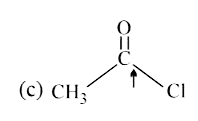In which of the following pairs, indicated bond having less bond dissociation energy :
CH3−C≡↑CH and HC≡↑CH
The correct Answer is:I
To determine which bond has less bond dissociation energy between the pairs given, we need to analyze the structures and the stability of the resulting radicals after the bond is broken.
1. Identify the Bonds:
- The first bond to consider is in propylene (CH₃-C≡CH) which has a carbon-carbon triple bond (C≡C).
- The second bond is in acetylene (HC≡CH), which also has a carbon-carbon triple bond.
2. Understand Bond Dissociation Energy:
- Bond dissociation energy (BDE) is the energy required to break a bond in a molecule. A lower BDE indicates that the bond is weaker and can be broken more easily.
3. Analyze Hybridization:
- In both cases, the carbon atoms involved in the triple bonds are sp hybridized. However, the surrounding groups differ.
- In propylene, one carbon is bonded to a methyl group (CH₃) which can donate electron density, while in acetylene, both carbons are bonded to hydrogen atoms.
4. Consider Stability of Radicals:
- When the bond is broken, we form radicals. In propylene, breaking the bond leads to a radical that is stabilized by the adjacent methyl group through hyperconjugation and inductive effects.
- In acetylene, the resulting radicals are less stabilized because they are only adjacent to hydrogen atoms, which do not provide the same level of stabilization.
5. Conclusion:
- Since the radical formed from propylene (CH₃-C≡CH) is more stable due to the presence of the methyl group, the bond in propylene has a lower bond dissociation energy compared to the bond in acetylene (HC≡CH), which is less stabilized.
Final Answer:
The bond in propylene (CH₃-C≡CH) has less bond dissociation energy compared to the bond in acetylene (HC≡CH).
---
- The first bond to consider is in propylene (CH₃-C≡CH) which has a carbon-carbon triple bond (C≡C).
- The second bond is in acetylene (HC≡CH), which also has a carbon-carbon triple bond.
- Bond dissociation energy (BDE) is the energy required to break a bond in a molecule. A lower BDE indicates that the bond is weaker and can be broken more easily.
- In both cases, the carbon atoms involved in the triple bonds are sp hybridized. However, the surrounding groups differ.
- In propylene, one carbon is bonded to a methyl group (CH₃) which can donate electron density, while in acetylene, both carbons are bonded to hydrogen atoms.
- When the bond is broken, we form radicals. In propylene, breaking the bond leads to a radical that is stabilized by the adjacent methyl group through hyperconjugation and inductive effects.
- In acetylene, the resulting radicals are less stabilized because they are only adjacent to hydrogen atoms, which do not provide the same level of stabilization.
- Since the radical formed from propylene (CH₃-C≡CH) is more stable due to the presence of the methyl group, the bond in propylene has a lower bond dissociation energy compared to the bond in acetylene (HC≡CH), which is less stabilized.
The bond in propylene (CH₃-C≡CH) has less bond dissociation energy compared to the bond in acetylene (HC≡CH).
Topper's Solved these Questions
- GOCBOOK - MOTIONCHAPTER - GOCEXERCISE - Exercise - 3
44 Videos
- GOCBOOK - MOTIONCHAPTER - GOCEXERCISE - Exercise - 4 Level - I
13 Videos
- GOCBOOK - MOTIONCHAPTER - GOCEXERCISE - Exercise - 2 (Level - I)
31 Videos
- GASEOUS STATE BOOK - MOTIONCHAPTER - GASEOUS STATE EXERCISE - EXERCISE-4( LEVEL-II)
19 Videos
- GRIGNARD REAGENTBOOK - MOTIONCHAPTER - GRIGNARD REAGENTEXERCISE - EXERCISE-2
16 Videos
Similar Questions
In which of the following pairs, indicated bond having less bond dissociation energy :
 and CH2=↑CH2
and CH2=↑CH2
View SolutionIn which of the following pairs, indicated bond is of greater strength :
 and CH3−CH2−↑ Cl
and CH3−CH2−↑ Cl
View SolutionIn which of the following pairs, indicated bond is of greater strength :
CH2=CH−↑ CH=CH2 and CH2=CH−↑ CH2−CH3
View SolutionIn which of the following pairs, indicated bond is of greater strength :
CH3−CH2−↑ Br and CH3−CH2−↑ Cl
View SolutionIn which of the following pairs, indicated bond is of greater strength :
CH3−CH=CH−↑ Br and CH3−−→C∣BrH−CH3
View SolutionWhich of the following pairs has higher resonance energy:
 and CH2=CH−CH=CH−CH=CH2
and CH2=CH−CH=CH−CH=CH2
View SolutionWhich of the following pairs has less resonance energy:

and CH2=CH−CH=CH2
View SolutionWhich of the following pairs has less resonance energy:

⊕ and CH2=CH−CH+2
View SolutionWhich of the following pairs has less resonance energy:

Ө and CH2=CH−CH−2
View SolutionList the following carbocations in the order of decreasing stability :
CH3C∣CIHCH2CH+2,CH3C∣CH3HCH2CH+2,CH3CH2C∣CIHCH+2
View Solution
